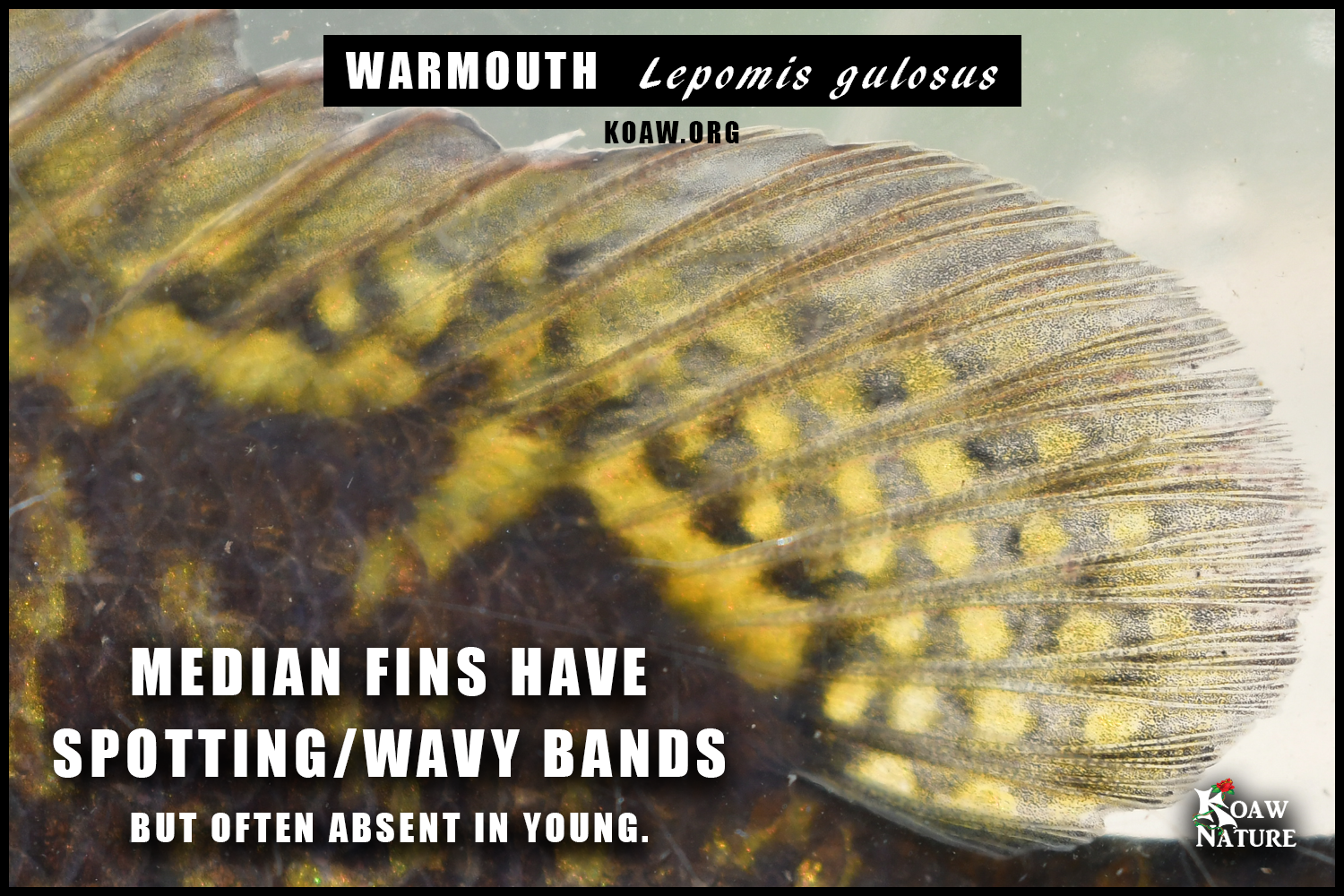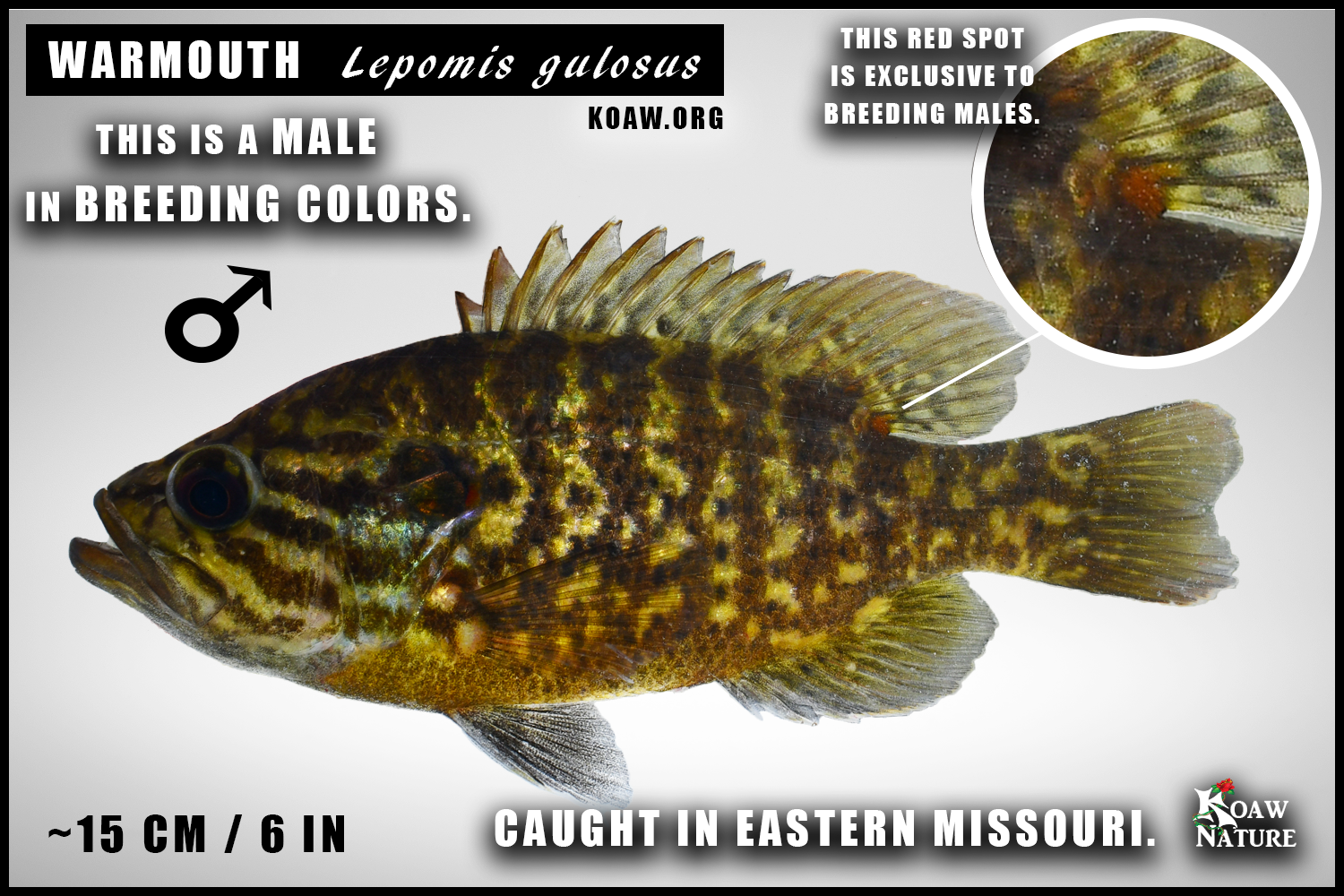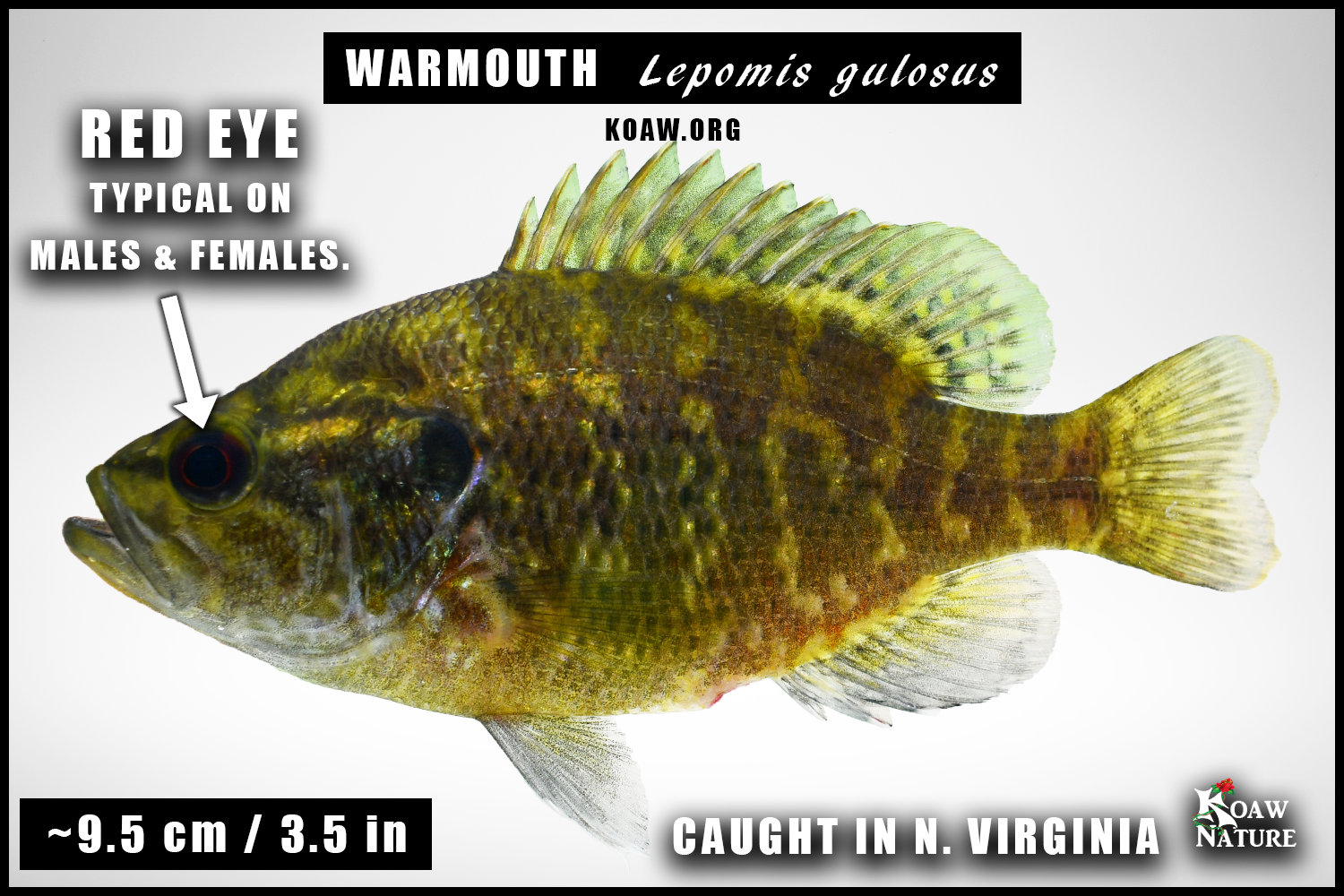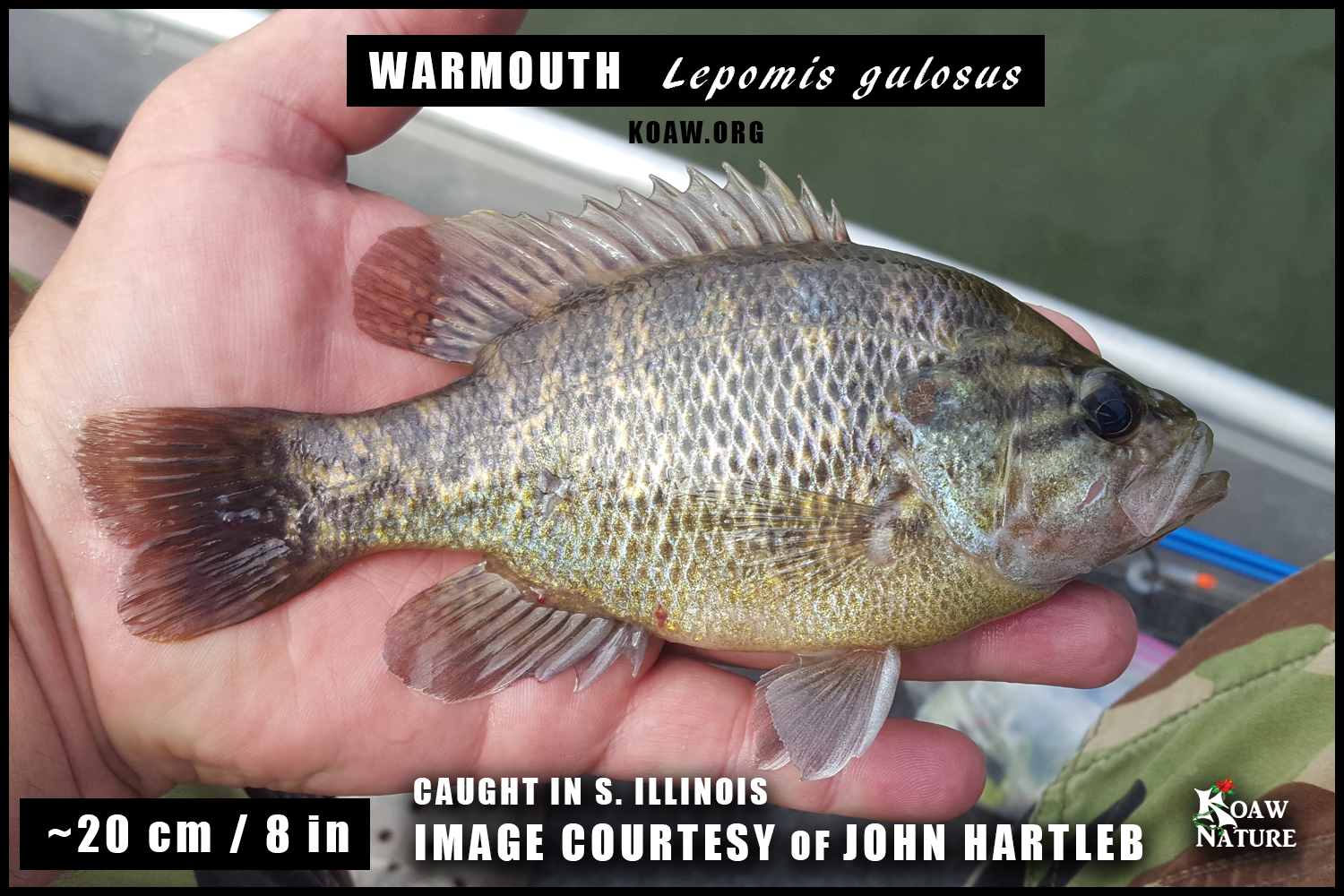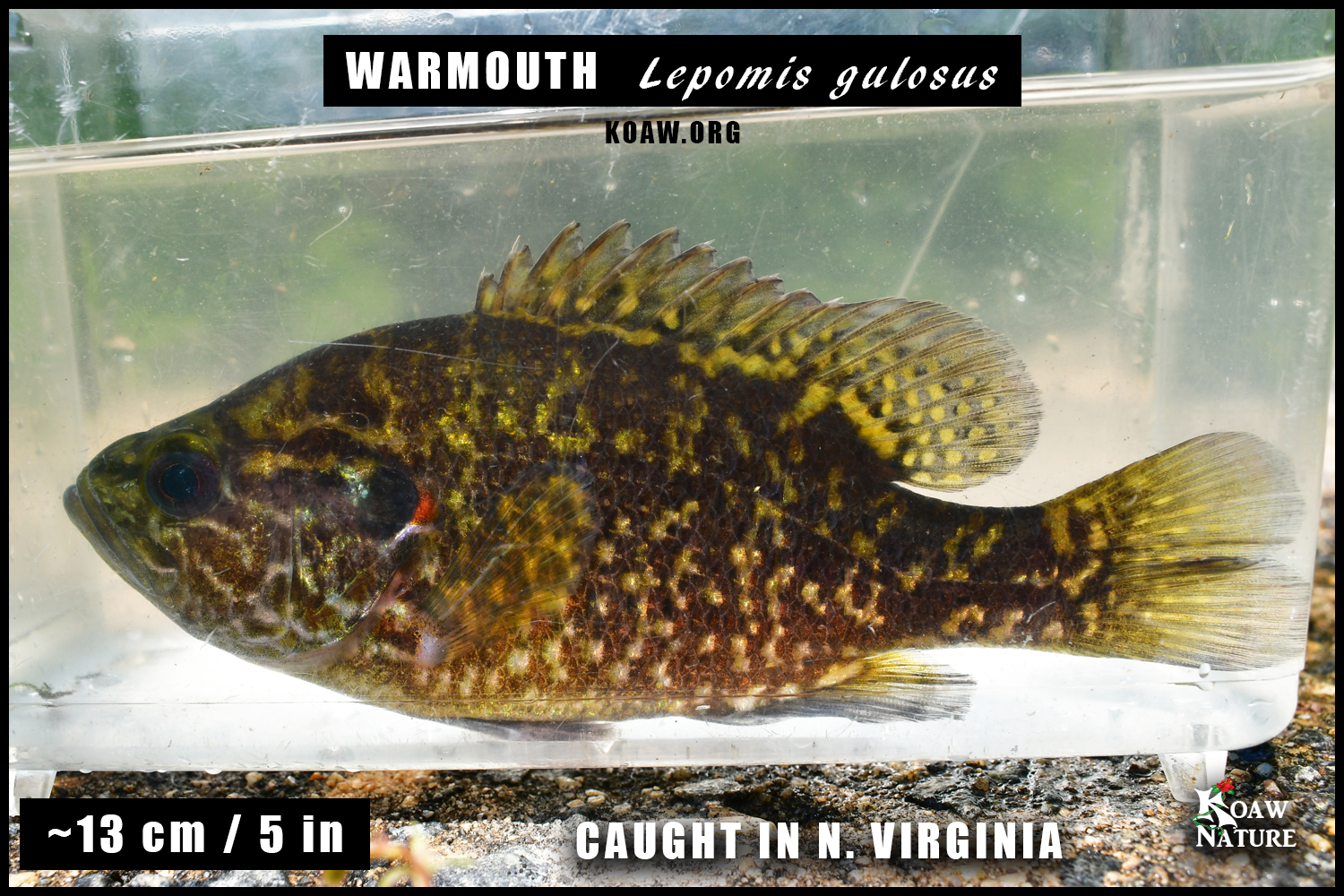By Koaw - November, 2020 (Updated October, 2022)
GENERAL: The warmouth (Lepomis gulosus - Cuvier 1829) is species of sunfish with a very large mouth and is always a treat to encounter. Similar to the esocids (muskie, pike & pickerel), the warmouth is a lie-and-wait predator, often hiding in cover and waiting for a chance to ambush unsuspecting prey.
The dark lines radiating from the eyes, the large mouth and the teeth on the tongue are great distinguishing features.
Usually 10 dorsal rays (9-11), 10 dorsal spines (9-11), 13-14 pectoral rays, 9-10 anal rays. [1][2]
BODY: The warmouth has a deep, compressed body like the other lepomids though usually maintains a thicker and somewhat more elongated profile. The lateral line is complete with 36-45 lateral scales. [1] [2]
KEY FEATURE: A small patch of teeth is present on the tongue which is a feature present on the warmouth and no other lepomid; though rarely present on the green sunfish (L. cyanellus). These teeth on the tongue are called glossohyal teeth. [3] Check out the photo I grabbed that clearly shows a small patch of teeth on the tongue.
Give it a Feel: If you’re uncertain about seeing teeth or not then don’t be shy to feel the teeth as they aren’t terribly sharp; the teeth feel like sandpaper. Even a small warmouth should have a big enough mouth to let you stick a finger in and gently feel the tongue. Keep in mind that there will be other patches of ventral teeth more posterior (behind the tongue) in sunfishes[4]; the tongue is anterior in the mouth, or right near the opening.
When the warmouth hybridizes with the bluegill (Lepomis macrochirus) the offspring will likely not have any teeth on the tongue. Though, the hybrid offspring will likely have moderately developed teeth on the palatines and vomer which is intermediate of the two parent species. (Those teeth are on the roof of the mouth near the front.) The warmouth has well-developed dentition on the palatines and vomer while the bluegill’s dentition is absent and poorly developed on the palatines and vomer, respectively.[2]
COLORATION: The warmouth has distinct dark red/brown lines radiating from the back of a reddish brown eye with light lines running along the mid-to-lower head. Often the body is a dark brown/olive color on top with irregular mottling and bars along the side [5]. A purplish overall sheen may be visible. The belly is cream to yellow in color. The fins have spotting or wavy bands that are often absent on young. [1]
Breeding males have pronounced colors and patterns including a bright red/orange spot at the base of the 2d dorsal fin. [1] (See the photo of the breeding male in the photo carousel above.) Breeding males usually also have brighter red eyes. [5]
Southern populations, such as in Texas and Florida, tend to express more red or orange spots along the body, especially on breeding males. Few populations of warmouth will have red margins on the median fins, as is seen in certain Ohio populations.
Click to enlarge.
At times it may seem like there are light bluish green spots/blotches on the body if the light is hitting the scales at a certain angle from the viewer’s perspective. These ‘spots’ are much less apparent and far less regular in formation compared to the much more conspicuous blue spots on lepomids like a green sunfish (L. cyanellus) or dollar sunfish (L. marginatus). On dark warmouth phenotypes, the light blotches on the body really pop out. (See adjacent image.)
Click to enlarge this juvenile warmouth photo.
SIZE: To 31 cm (12 in). [2] IGFA All-Tackle World Record: 1.10 kg (2 lb 7 oz) [3]
OPERCULAR FLAP: The opercular flap or “ear flap” often has a light edging with a red to purple half-moon spot. This flap is short. Sometimes the red/purple color is very faint or hardly visible.
Often the black portion of the ear flap will have a multi-colored iridescence.
GILL RAKERS: The gill rakers on the 1st gill arch are long and thin similar to that of a bluegill (Lepomis macrochirus) and green sunfish (Lepomis cyanellus). These can be observed by gently lifting the gill plate and examining the white portion above the red filaments that are closest to the gill plate.
I made a video describing how to locate and find these rakers that is hosted on Koaw Nature’s Fishing Smarts YouTube channel.
MOUTH SIZE: The warmouth has a very large mouth. The upper jaw often extends under or past the pupil of the eye (while the mouth is closed or nearly closed.)
More specifically, the most posterior edge of the maxilla will align underneath the eye’s pupil or past the anterior edge of the eye’s pupil.
PECTORAL FIN: The warmouth has a short and rounded pectoral fin that will generally not pass the eye if bent forward. Typically there are 14 pectoral rays. [1]
At times, the pectoral fin, if bent forward, will not even reach the posterior edge of the eye.
HABITAT: Find warmouth in vegetated lakes and ponds as well as the backwaters of creeks and over muddy substrate. [1]
True to its nature as a lie-and-wait predator, most of the warmouth I sampled for my Lepomis survey were caught hiding underneath rocks, logs and thick vegetation in moderately-deep pools within creeks and in the waters behind dams of lakes. Warmouth love cover!
In my field work, I often find warmouth in swamps cohabitating with species of Enneacanthus (banded sunfishes).
CLICK TO ENLARGE - This distribution map is an illustrated approximation created by Koaw primarily pulling data and information from USGS-NAS, Research Grade observations from iNaturalist and Page & Burr’s Field Guide to Freshwater Fishes.
LOCATION: Native to the Great Lakes River Basin and Mississippi River Basin extending to the southern coastline. Also native to the Atlantic and Gulf drainages from the James River in Virginia and the northern parts of the Rio Grande Basin. [7] [1]
This species has been widely introduced across the United States with scattered populations along the Pacific drainages. Introduced populations now exist in New Mexico, Colorado, Arizona, California, Oregon, Idaho, Washington as well as various states in the northeastern parts of the United States including Connecticut and perhaps even further north in New Hampshire. [8] [7] [1]
FISHING: A warmouth is always a treat to catch. I noticed (while fishing profusely for this Lepomis survey) that warmouth were often hiding underneath rocks and fallen trees while other sunfishes in the same area, such as redbreast and bluegill, were more often willing to swim nearer to the surface. A warmouth would suddenly dart out of a hiding spot and nab the bait.
Warmouth did not often take flies. Instead most of the warmouth I caught during this survey took live bait like worms or chopped shrimp. When targeting warmouth around other sunfishes, I made the bait profile large as that seemed to entice warmouth to strike with better success than sunfishes with smaller mouths, like bluegill.
SIMILAR SPECIES: The warmouth is most often confused with the rock bass (Ambloplites rupestris), especially younger rock bass that retain more of the irregular mottling and saddles. I threw together a quick reference for a few key features to look for that easily distinguish the two species. (Click on the adjacent image to enlarge it.)
The warmouth has 3 anal spines while the rock bass will have 5-7. The warmouth normally has 10 dorsal spines, though sometimes 9 or 11, while the rock bass has 11-13. The warmouth has the dark lines radiating from the eyes as well as color on the ear flap while the rock bass typically only has a single thick and vertical dark line coming from the eye, often called a “tear drop” or a suborbital line.
Both species have a small patch of teeth on the tongue.
Acantharchus is a monotypic genus, meaning it contains only one species: the mud sunfish (Acantharchus pomotis). This species holds quite a similar resemblance to small warmouth. Both species have dark lines radiating from the eyes and a deep, compressed body that is moderately elongated. The quickest way to tell any species within Lepomis apart from the mud sunfish is by looking at the caudal fin as all lepomids have an indented caudal fin while the mud sunfish has a rounded caudal fin. Counting spines in the median fins is the next best analysis.
Below you’ll see a graphic I’ve created that shows a smallmouth bass and warmouth of similar sizes. Any black bass will have an elongated body while the warmouth body, though more elongate than most other lepomids, is still much deeper than any black bass. Also, black basses typically have 12-15 dorsal rays while warmouth typically have 10 (9-11) dorsal rays.
REFERENCES:
L. M. Page and B. M. Burr, Peterson Field Guide to Freshwater Fishes, Houghton Mifflin Harcourt Publishing Company, 2011.
R. S. Birdsong and R. W. Yerger, "A Natural Population of Hybrid Sunfishes: Lepomis macrochirus × Chaenobryttus gulosus," American Society of Ichthyologists and Herpetologists ASIH, vol. 1967, no. 1, pp. 62-71, 1967.
G. S. Helfman, B. B. Collette, D. E. Facey and B. W. Bowen, The Diversity of Fishes: Biology, Evolution, and Ecology, 2nd Edition ed., Wiley-Blackwell, 2009, p. 29.
N. K. Thakur, M. Takahashi and S. Murachi, "Osteology of Bluegill Sunfish, Lepomis macrochirus RAFINESQUE," J. Fac. Fish. Anim. Husb., vol. 1971, no. 10, pp. 73-101, 1971.
R. P. Jacobs and E. B. O'Donnell, "Sunfishes and Freshwater Basses," in Freshwater Fishes of Connecticut, Hartford, Connecticut Dept. of Environmental Protection, 2009, pp. 164-180.
IGFA, "IGFA World Records Warmouth Lepomis gulosus," [Online]. Available: https://igfa.org/igfa-world-records-search/?search_type=ScientificName&search_term_1=Lepomis&search_term_2=gulosus. [Accessed 2020].
USGS, "USGS NAS Lepomis gulosus," [Online]. Available: https://nas.er.usgs.gov/queries/SpeciesAnimatedMap.aspx?SpeciesID=376. [Accessed August 2020].
iNaturalist, "Lepomis gulosus Warmouth," [Online]. Available: https://www.inaturalist.org/taxa/104252-Lepomis-gulosus. [Accessed August 2020].
